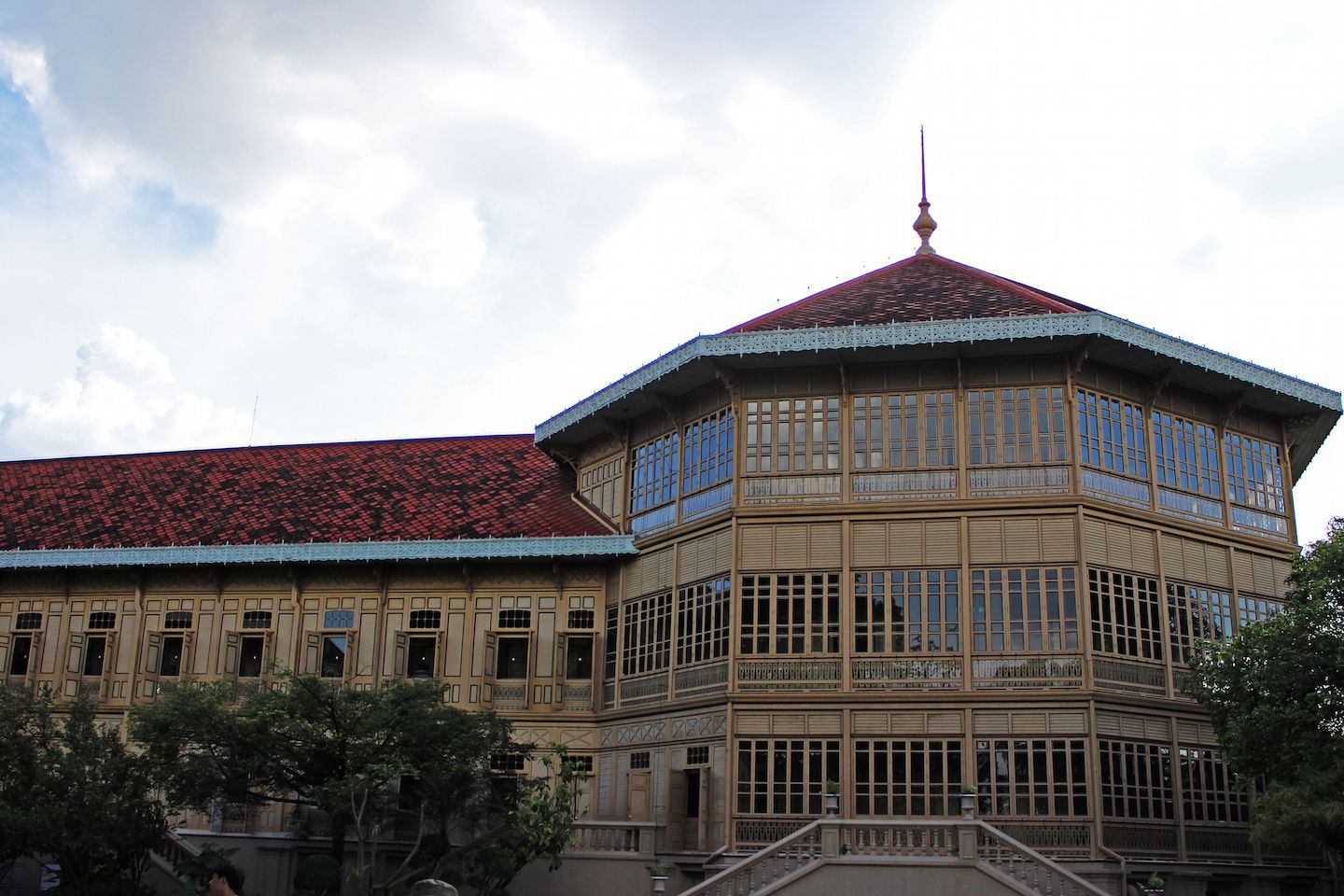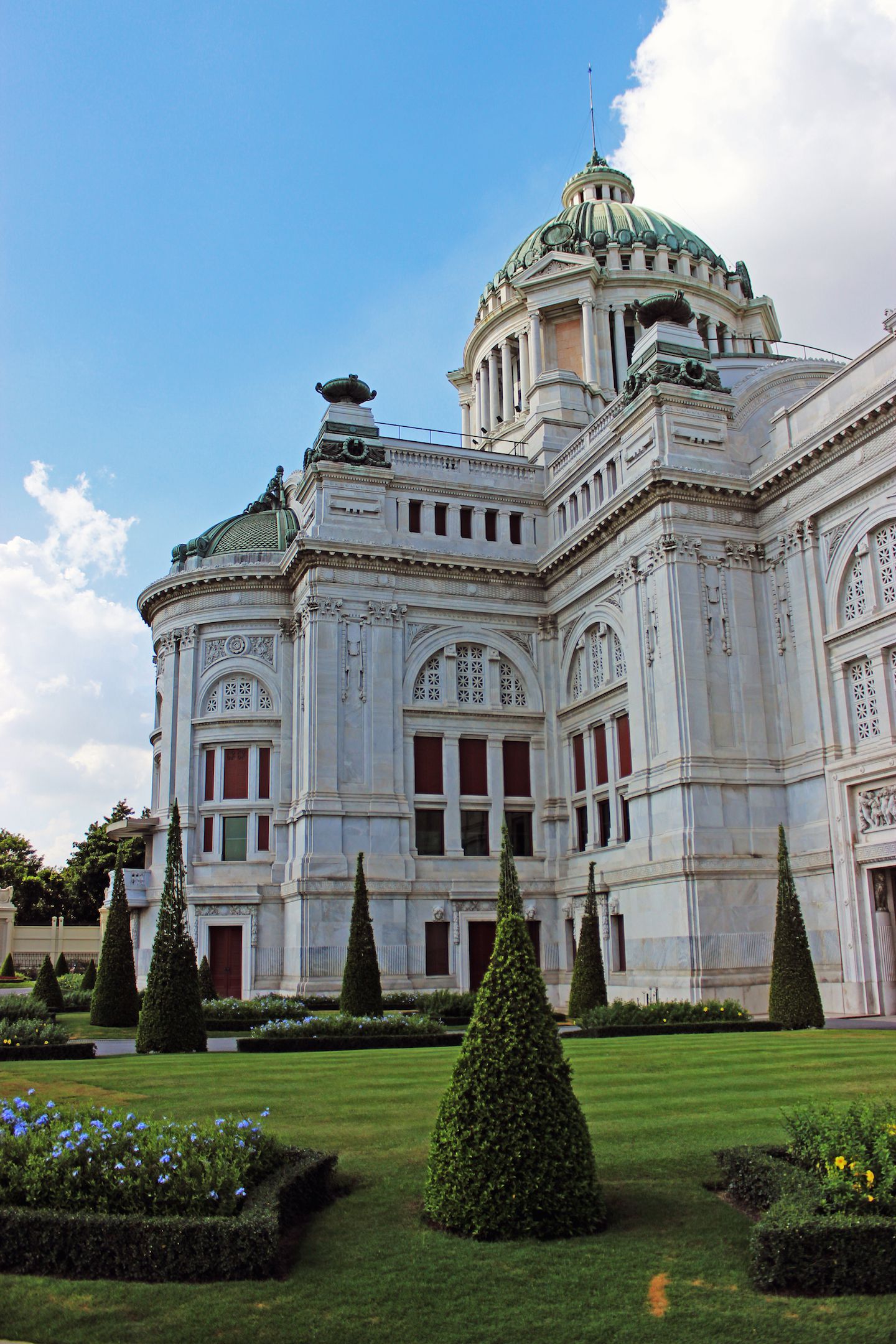We have already seen three of the most historic and iconic symbols of Thai culture in Bangkok, but before we left, we decided to see one more place. Our tickets to the Grand Palace included free entry to the Vimanmek Mansion and Ananta Samakhom Throne Hall – two parts of what is known as the Dusit Palace that are open to the public. So we thought we might as well go visit since we already paid for it! Cameras and belongings were strictly not allowed inside any of the buildings, so any photos are only of the outside.
Dusit Palace
We had a mad confusing start at Dusit Palace. Our taxi dropped us off at the exit of the palace and as we walked in, the place was packed with tour groups. We felt like we were the only ones who were not part of a tour. Having no idea where to go, we first walked to a smaller side building that we thought was a ticket office, considering the amount of people around; however, we looked around and only saw a gift shop, restrooms, and lockers.

After asking for directions, we ended up at the entrance to the Ananta Samakhom Throne Hall. It was here that the guard told us the Vimanmek Mansion closed earlier, so we should go there first. We headed in the direction he pointed, but instead of another building like we expected, it turned out to be a whole other section of the grounds. This place was huge! Still lost, we asked a lady by the door of the closest building. She convinced us that we needed to lock our bags in this building’s lockers and wait inside until someone could trade our Grand Palace tickets into individual ones for Vimanmek Mansion and Ananta Samakhom Throne Hall. Having no better ideas, we waited inside and walked through what appeared to be the textile exhibition of the queen – now we were just wasting time! We tried to ask this other tourist, but he was equally lost and didn’t even know about the ticket package. After walking through the exhibition, the lady finally directed to a golf cart and said someone will drive us to Vimanmek Mansion. We sat on the back of the golf cart thinking this was the weirdest thing.

True to the lady’s word, the golf cart brought us to Vimanmek Mansion. Finally! After trading our tickets and passing by way too many entrance signs that only led to yet another path, we reached the locker room. We officially entered the mansion an hour after we arrived at the grounds initially.
Vimanmek Mansion
The largest golden teakwood mansion in the world, Vimanmek Mansion was built in an European style. It was said that King Rama V conceived the idea after seeing royal palaces during a visit to Europe. He found the Grand Palace to be increasingly crowded and stiflingly hot, especially given his affinity for the outdoors. Dusit Palace was built as another royal residence outside of the Grand Palace. Queen Sirikit, the wife of the current king (King Rama IX), renovated Vimanmek Mansion to commemorate King Rama V.

Inside the house, there were exhibitions in almost every room. Personal photographs, artifacts, and handicrafts were on display. Some portraits of the king were in the style typical of European royals. Gifts and keepsakes from King Rama V’s trips to Europe were also on display. While it was a very nice space, we both felt strange about seeing such European decor in Thailand. It was clear that the mansion was a much more laid-back royal residence.
Ananta Samakhom Throne Hall
This place wowed us the most out of everything in Bangkok. Even though I had to buy a sarong because ladies could only wear long skirts which I wasn’t happy about, I forgot all about it by the time I entered the Ananta Samakhom Throne Hall. Our entire time inside the hall can only be described as jaw-dropping from beginning to end.

The hall led us through a series of Thai traditional art exhibitions from thrones and paintings, to carved walls and silk embroideries, all created by artisans at the Sirikit Institute. The ceiling was a masterpiece of extremely detailed and exquisite paintings, reminiscent of the Sistine Chapel in Vatican City. All paintings depicted history of the current ruling royal house of Thailand (Chakri Dynasty). Large pieces of art were on display, ranging from thrones to boats to crowns to panels. All of these pieces were made in gold and silver, with diamond embellishment and beetle wing collages. It was like seeing impossibly gorgeous and well-crafted artwork made out of the most expensive jewels, one after another. We couldn’t help but wonder how much the entire place must be worth.

Later on, the exhibits shifted from golden jeweled art pieces to wooden carvings and silk embroideries. This may sound like a downgrade, but if anything it was even more breathtakingly beautiful. Gold and jewels naturally look more expensive and draw attention. The fact that the walls of wooden carvings and silk embroideries looked just as extravagant as the gold was truly impressive. I had never seen such detailed wooden carvings of entire sceneries with depth and perfection. The walls of embroidery used the best silk threads and looked like real paintings that glowed. We went crazy with every new art piece we saw.
Every visit to Bangkok should include a stop at the Ananta Samakhom Throne Hall and Dusit Palace in general, because there is no better place to see the most finely crafted traditional Thai art. Even if you don’t know and don’t care about Thai art, that kind of opulence, grandeur and wealth needs to be experienced in person.
For more pictures from Bangkok, please visit the gallery!
